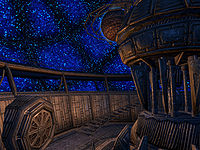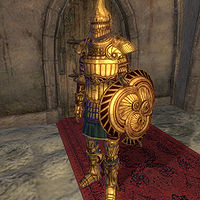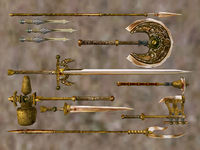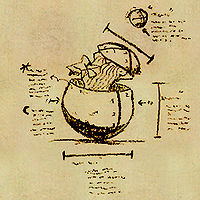Lore:Dwemer
| Para manter o padrão de qualidade do nosso site, este artigo ou seção pode precisar de limpeza. O usuário que colocou isto aqui teve a seguinte preocupação: The discussion of their disappearance should be polished up, with more reliance on Vivec's The Battle of Red Mountain and other accounts of their disappearance during the battle. It should also be split off into its own History sub-section. Para deixar uma mensagem sobre a limpeza deste artigo, por favor adicione-a na página de discussão do mesmo. |


The Dwemer (/dwɛ.mɚ/ dwem-mer, /dweɪ.mɚ/ dway-mer or /dwiː.mɚ/ dwee-mer), the "people of the deep", are a fabled "Lost Race" of Mer from Dwemereth, which mostly consisted of modern-day Morrowind, where they are believed to have been the most prolific, though they also had a strong presence in Hammerfell, High Rock, and Skyrim. Meric races use the term "Dwemer", which translates to "Deep-Elves" or "Deep Folk". Men commonly refer to them as Dwarves. The early history of the Dwemer is still clouded in mystery. There is no known story of their dissociation from the Aldmer, which must have occurred very early in Tamrielic history, as their society bore few correlations with that of the Altmer besides some similar legal principles. According to legend, the Dwemer originated from the same group as the Dunmer, and were treated as another tribe, and later, as a secular Great House. [oog 1][oog 2] The Dwemer built elaborate underground cities near and beneath mountain ranges, including the Velothi Mountains and Red Mountain, and in the mountains of the isle Stros M'Kai. Many misconceptions about them have abounded for centuries: scholars long thought that most Dwemer ruins which dotted Tamriel outside Morrowind were mere outposts and that there were few significant Dwemer settlements elsewhere until 1E 420. The presentation of the Dwemer in fictitious but popular novels like the Ancient Tales of the Dwemer has also lodged an inaccurate impression of them in the popular consciousness, painting them as familiar, comfortable characters very similar to humans. In reality, they are better described as having been fearsome, unfathomable, and even cruel, though also careful, intelligent, and industrious. Their society consisted of free-thinking yet reclusive clans devoted to the secrets of science, engineering, and the arcane until they mysteriously disappeared around 1E 700.
For more information, see the main lore article.
History

The history of the Dwemer is mostly a record of their conflicts with other races and each other, and the timeline is imprecise for many of these events. They purportedly settled along the coasts of Morrowind and founded Dwemereth. They became involved in clashes with the newly-arrived Chimer in the Late Middle Merethic Era over land, resources, and religion. The Dwemer also inhabited modern-day Skyrim during the earlier centuries of the First Era, and had numerous clashes with the Nords who lived there.
While King Harald is credited with driving the last of the "elves" out of Skyrim before the end of his reign in 1E 221, this is mostly likely referring to conflicts with the Snow Elves and possibly other elves, as the Dwemer kept inhabiting a number of city-states stretching from the Velothi Mountains as far west as Markarth in what is now the Reach. The city-states burrowed deep underground, masking their true size, and several of them were linked by the gargantuan cavern known as Blackreach (or "FalZhardum Din" to the Dwemer). They clashed often with the Nords, but were never seriously threatened until the third century of the First Era, several decades after Harald's reign, when the Nordic armies under High King Gellir experienced unusual success in conquering Dwemeri cities. Scholars believe that several decades before, an alliance emerged between four city-states led by Arkngthamz, a Dwemeri research center, to develop technology to harness the power of the Aetherium crystal, but the alliance became a victim of its success and crumbled quickly. All of the city-states in Skyrim are thought to have entered into a crippling war over the Aetherium crystal and the means of harnessing it. After decades of this underground war, the Nords were able to sweep the weakened Dwemer out of their city-states and hold them for a century before the Dwemer could muster the strength to reclaim them.
The Snow Elves, meanwhile, had not actually been driven out of Skyrim by Harald, either; many of them sought sanctuary with the Dwemer. Although they agreed to provide them safe haven in their underground realm, the distrustful Dwemer rendered them blind by forcing them to consume toxic fungi once found growing deep underground. The Snow Elves became servants of the Dwemer, and then, after several generations, into their corrupted slaves, the Falmer.
Clashes continued with the Chimer in Morrowind, and the two races apparently disliked each other greatly. Dwemeri culture was agnostic and preferred reason to faith, while the Chimer were staunch Daedra-worshippers. However, the Nordic invasion and conquering of present-day Morrowind under High King Vrage around 1E 240 brought a common enemy the Chimer and Dwemer could unite against. Dumac Dwarfking and Indoril Nerevar forged an alliance which ultimately succeeded in repelling the invaders in 1E 416, leading to the First Council of newly-named Resdayn.
In 1E 420, the militaristic Rourken clan opposed the accord with the Chimer and chose self-exile. Their chieftain is said to have thrown the Volendrung Hammer across Tamriel and led his clan to wherever the hammer fell, an image which has been depicted in a number of ruins in Hammerfell. The Rourken named the land "Volenfell," which later was somewhat mistranslated to "Hammerfell".
Meanwhile, in Skyrim, after generations of subjugation, the Falmer rebelled, leading to the War of the Crag, another massive Dwemeri war which was waged far below the surface while the Nords above remained oblivious. The war lasted decades, and only ended when the Dwemer did.
The Dwemer inexplicably disappeared during the Battle of Red Mountain, the biggest and final battle of the War of the First Council. This purportedly came about due to the efforts of Lord Kagrenac, who was the Chief Tonal Architect of the Dwemer responsible for designing the great freeholds of their Second Empire.[nb 1] Kagrenac constructed Kagrenac's Tools to harness the powers of the Heart of Lorkhan, which the Dwemer had discovered beneath Red Mountain. When the Chimer found out, they considered this aim blasphemous and sought to stop it. Kagrenac's exact goal remains unclear, but it is believed he sought to heighten his race to Anumidum. The disappearance of a whole race in an instant sparked many theories, but is generally thought to have followed this attempt to use the tools on the Heart, and simply coincided with the war. It appears that the Dwemer were conflicted on their use of the Heart. Some opposed its use, warning that massive side effects were likely, while the majority of the Tonal Architects, including Kagrenac, and Bthuand Mzahnch (who wrote The Egg of Time which downplayed the risks of tampering with the Heart of Lorkhan) wished to proceed.
It appears all members of the Dwemer race were simply removed from the world. When the previously untouched Dwemer ruins of Bamz-Amschend in Mournhold were rediscovered, numerous piles of ashes were present next to weapons and armor, on chairs, and in beds, suggesting the Dwemer's bodies were suddenly reduced to ash in some way. In 4E 201, Arniel Gane, a researcher at the College of Winterhold in Skyrim, attempted to recreate the circumstances of the Dwemer's disappearance after obtaining Keening, one of Kagrenac's Tools, but vanished suddenly in the process, strengthening the theory that Kagrenac's use of the tools was the cause of the disappearance. Some scholars still resist the notion that the Dwemer disappeared all at once.
A theory also exists that their sudden extinction was caused by their reversal of the usual processes involved in the Earth Bones, the laws of nature. Rather than creating the profane by commanding the sacred, such as in Conjuration magic or Daedra worship, they sought to create Anumidium, their own sacred, from the "deaths of the profane". Vivec, the warrior-poet god of the Dunmer, similarly believed that the disappearance of the Dwemer is in some way owed to their "divine sin"—attempting to create a god for their own purposes from the remains of the god Lorkhan. Whether their use of Kagrenac's Tools in this process or simply their intentions resulted in their extinction remains unclear in this theory.
The Dwemer purportedly possessed an ability that was known as "The Calling", which seems to have been similar to telepathy. It allowed the Dwemer to communicate with each other over great distances. It has been suggested that, in the last moments before they disappeared, Lord Kagrenac used The Calling to summon all of the Dwemer people and rally them to carry out his plans to transcend the Mortal Plane. Whether this was related to their demise or not is uncertain.

Technology
The Dwemer appear to have been a highly technologically advanced and particularly dogmatic race. Others races have still not cracked the secret behind their metal. Their weapons were simple but effective; weaponsmiths relied on creating quality materials first, and merely allowed the form of those materials to flow from the method of the weapon's use. Their mastery of steam and geothermal power through tapping into the natural lava sources under Morrowind allowed them to create airships, sentient machines, mechanical observatories, and lighting systems that continued to work for centuries without any maintenance. Most of their settlements are still inhabited by Animunculi, enchanted mechanical guardians, commonly known as "Centurions" or "Spheres". They appear somehow linked to their place of origin, and will lose power if removed from the vicinity. This may explain why many Animunculi remain active even after so long, and supports the theory that they are strongly influenced by magic. Additionally, it appears that some Animunculi are capable of interpreting the actions of people around them - in a sense, 'perceiving' their intent - and responding accordingly. The Dwemer were somewhat comforted by their ability to empower lifeless fabrics into active beings, denying the organic power of the gods while at the same time transcending the mortal systems of life. This culture, often seen as sheer arrogance by others, allowed their technological capabilities to accelerate well ahead of any other race. In addition, the Dwemer also appear to have dabbled extensively and somewhat successfully in some of the more divine (or arcane) arts and sought to harness the supernatural powers of the Divines within their mechanical technology, even keeping an Elder Scroll within the massive underground complex of Blackreach in Skyrim.
Very little is known about Dwemeris, the Dwemeri language, but there have been many attempts to translate it using Aldmeris for reference and comparison. Several different, incomplete styles of written Dwemeris appear throughout Tamriel. The glyphs found in the ruins on Stros M'Kai differ significantly from those found in Cyrodiil and Morrowind, which suggests there may have been dialects or variations across the Dwemer clans. Some of spoken Dwemeris remains in prefixes and suffixes in historic names, such as "Volen-", meaning "hammer", and "-Fell" meaning "city", giving Volenfell; "City of the Hammer".

Architecture
The Dwemer lived in strongholds, often called Freehold colonies or city-states, which are typically laden with ancient steam-powered contraptions, many of which are still running. They are thought to have delved down to a certain threshold in the ground, known as a "Geocline", before they began building the vital structures of a colony. There are hundreds if not thousands of Dwarven buildings made of precise square shapes, but far fewer examples of rounded or curved stonework, suggesting the Dwemer favored well-calculated designs based on angled lines rather than riskier, more imprecise calculations using arcs and curves. Numerous pipes can be found in and around Dwemer ruins, and many devices and constructs appear to emit steam from their inner workings. There may be "boilers" or similar components housed inside the Dwemer Centurions. It has been speculated that the constructs are powered by some kind of checkpoint in each ruin, or possibly by the combined signal of every ruin's mechanics, but this is not certain. There seem to have been regional differences in architectural and engineering styles; for instance, the prevalent style amongst northern clans is now known as "Deep Venue", wherein several structures are built within natural caverns. Arcanex are smaller, largely above-ground structures which are believed to have been research centers of some kind, though little is known about them thanks to looters. Animoculotories are Dwemer factories found within many strongholds.
Dwemer constructs taken from Vvardenfell, where many Dwemer ruins are present, appear to shut down when a certain distance between them and Red Mountain is reached. However, it does seem that many objects that may be found in ruins were once covered in mesh or cloth, which has decayed over the years. This would explain why the "home comforts" of the Dwemer may seem very spartan to a visitor. There are also few large halls in most ruins. This could be due to the fact that most if not all Dwemer ruins are underground, where large interior spaces are difficult to fashion at best. Many Dwemer colonies were named after their rulers. The largest concentration of strongholds is in Vvardenfell (which translates as "City of the Strong Shield" in Dwemeris). Many Redguards in Hammerfell have shown a particular interest in the Dwemer ruins there for unknown reasons. Theories persist that Yokuda, the original homeland of the Redguards, was an ancestral Dwemer city.
Appearance
Contrary to many legends, archaeological evidence of known Dwemer ruins leads one to believe that they were about the same size as the typical human or elf, evidenced by the fact that all existing Dwarven armor is average sized (although some claim that "Dwarven armor" is either the outer shells of machines or mismatched pieces from various devices). It's speculated that the moniker "dwarf" may have been given long ago by the giants of the Velothi Mountains, who would have perceived them to be unusually small and thus deemed them to be "Dwarves". Imperial excavation of Dwemer ruins supports the Dlyxexic theory that the translation of Dwemer as Deep Elves might also be read as Smart Elves. Indeed, perhaps the brilliant students of the Ehlnofey mentioned in The Anuad are the Dwarves themselves. Purported descriptions of the last living Dwemer cannot be relied upon, as he was admittedly bloated and deformed by Corprus, and the only other visual examples come from sculptures and Dwarven Spectres found in their ruined dwellings. It can be deduced, however, that long beards were popular among the lost elves, and they preferred heavy metal armors and robes. Their remaining features could be described similarly to that of the other elven races, as no specific information exists.



Philosophy
It is unknown whether the Dwemer worshipped any gods. However, it is known that they despised and scorned the Daedra, and mocked the "foolish" rituals of their followers, "prefer[ring] instead their gods of Reason and Logic". These may be metaphorical or literal terms; Vivec, the author, capitalized them in his writings which could be interpreted as an emphasized admonishment of their idolatry by means of substituting spiritual worship with absolute faith in those ideas. It could also be meant to suggest some sort of deified representation of those ideas or aspects of Dwemer thought. Since the Heart of Lorkhan offered some form of shared spiritual link among the Dwemer attuned to it - this could also refer to the collective reason and logic of the Dwemer people given voice through the powers of tonal architecture and the heart of a dead god. The Dwemer religion, if it can even be called that, is said to be one of the most complex and difficult puzzles of Dwemer culture.
Artifacts
Dwemer artifacts are highly prized throughout the Empire for trade and collecting, although since they are technically the property of the Emperor under various Imperial charters, the sale of them is often illegal. This does not seem to stop artifacts from falling off the backs of wagons or otherwise disappearing into various collections. Everything from armor to housewares is greatly sought after, and smugglers will risk execution if caught for such a profitable trade. Dwemer weapons and armor are especially valued, renowned for their excellent craftsmanship and sturdy design. However, acquisition of these artifacts is extremely dangerous, chiefly due to the remote locations of the ruins, and the multitude of aged and unreliable Dwemer machinery within, including the Centurions and other Animunculi, as well as sophisticated traps of which the Dwemer were particularly fond.
Notes
- Little is known of the Second Empire of the Dwemer. The Second Empire is mentioned in TES III: Morrowind by Yagrum Bagarn, the last living Dwemer. An available excerpt of Guylaine's Architecture of the Second Empire discusses common defenses and approaches to Dwemeri structures which were built during the time of the Second Empire.
- Falion, a Redguard wizard of the Fourth Era, claimed to have seen the Dwemer while walking the planes of Oblivion.
See Also
Books about the Dwemer
- The Aetherium Wars de Taron Dreth — A treatise on the collapse of Dwemer city-states in Skyrim
- Ancient Tales of the Dwemer de Marobar Sul — An incomplete series of fictional stories about the Dwemer
- Antecedents of Dwemer Law
- Chronicles of Nchuleft de An Anonymous Altmer — A historical chronicle of events in the Dwemer Freehold Colony of Nchuleft
- Dwarves de Calcelmo, Scholar of Markarth — A scholarly work on the culture and history of Dwemer
- Dwemer History and Culture de Hasphat Antabolis — A scholar's review of the Dwemer essays written by Marobar Sul
- Dwemer Inquiries de Thelwe Ghelein, Scholar — A series of scholarly essays on the elusive Dwemer
- Guylaine's Architecture de Guylaine Marilie — Guylaine Marilie's summary of historical Dwemer architecture, which has been somewhat invalidated by modern scholarship
- Nchunak's Fire and Faith de Nchunak — Nchunak's journey amongst the Dwemer and his attempts to understand the teachings of Kagrenac
- Ruins of Kemel-Ze de Rolard Nordssen — An archaeologist's adventure through ancient Dwemer ruins
- Secrets of Dwemer Animunculi — Diagramas de um Centurião-Esfera em diversos estágios
- The War of the First Council de Agrippa Fundilius — A brief account of a First Age religious conflict
Books in Dwemeris
- Divine Metaphysics — Uma explicação da montagem do Anumidium, escrita em Dwemeris
- The Egg of Time de Bthuand Mzahnch — Uma refutação de uma teoria popular entre os Dwemer, a qual dizia que o uso do Coração de Lorkhan envolveu riscos inadmissíveis.
- Hanging Gardens — A travel guide to the Hanging Gardens of Wasten Coridale, written in both Dwemeris and Aldmeris
Other Articles
- Morrowind:Dwemer Centurions - An article documenting the Dwemer Constructs encountered in Morrowind.
- Morrowind:Dwemer Ruins - A list of all the Dwemer ruins left on Vvardenfell.
- Morrowind:Dwarven - A description of the Dwemer armor found in Morrowind.
- Oblivion:Repairing the Orrery - An article describing the quest to repair the Arcane University's Orrery in the Imperial City.
- Skyrim:Dwarven - A description of the Dwemer armor found in Skyrim.
- Skyrim:Dwarven Automatons - An article documenting the Dwemer Constructs encountered in Skyrim.
- Skyrim:Dwarven Ruins - A list of all the Dwemer ruins left in Skyrim.
- Lore:Dwemer Alphabet - A study of Dwemeris, the Dwemeri language.
Gallery
-
DwemerBanner.jpg
A Dwemer banner with writing, as seen in Redguard
-
Dwemer weapons, as seen in Morrowind
-
DwemerDoor.jpg
A Dwemer door from Morrowind
References
Nota: as seguintes referências não são encontradas no jogo. Elas são incluídas para providenciar um fundo mais sólido ao artigo, mas podem não refletir lore estabelecida.
- ^ Gary Noonan explained the Dwemer and Dunmer's shared origins
- ^ According to Michael Kirkbride during the Redguard Forum Madness, the Dwemer were also considered a tribe during the time of the nation of Veloth
External Links
|
|||||||||||||||||||||||||||||||





